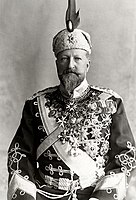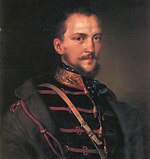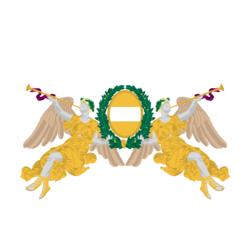Green Revolution
This article is incomplete because it is pending further input from participants, or it is a work-in-progress by one author. Please comment on this article's talk page to share your input, comments and questions. Note: To contribute to this article, you may need to seek help from the author(s) of this page. |
| Green Revolution | |||||||
|---|---|---|---|---|---|---|---|
| Part of the Euclean Spring and Liberalism in Euclea | |||||||
 The Battle outside Lenovo, May 7th 1868 | |||||||
| |||||||
| Belligerents | |||||||
|
| ||||||
| Commanders and leaders | |||||||
|
|
| ||||||
| Strength | |||||||
|
55,000 (Army) 2,500 (Guard) |
10,000 (Army) 4,000 (Partisans) (estimated) | ||||||
| Casualties and losses | |||||||
|
564 killed, 1,458 wounded |
1,841 killed, 2,783 wounded | ||||||
The Green Revolution (Tengarian: Зелена революция), also known mockingly as the Vladimirev's Folly (Tengarian: Глупостта на Владимирев) was a failed anti-monarchist revolt in the Empire of Tengaria in 1868 from May 4th to September 18th.
Inspired by the preceding events of the Euclean Spring, particularly the First Soravian Civil War, the Revolution was the long-awaited result of a gradual build up of republican and nationalist ideals in Tengaria, and one of the last manifestations of the Euclean Spring. It was in large part planned and inspired by students and teachers in the University of Lenovo, and from disillusioned units of the Imperial Army who had been without pay for some months. An unpopular taxation law by the administration of Simeon III saw the outbreak of riots in the streets of Lenovo, which were used by Boris Vladimirev, a professor at the University and the figurehead of Tengarian republican movement, to encourage an uprising. Soon armed groups and mobs, known as Partisans, had taken almost half of the capital, while Gregori Hristoforev and a division of the Imperial Army mutinied and declared support for the Republicans. The Imperial forces defeated the army and prevented it from entering the city, before marching into the city and crushing the insurrection, where Vladimirev was killed in the fighting. For the next few months the Imperial Army chased and ultimately cornered Hristoforev's Army, and finally ended the revolt by September of the same year.
The leaders of the revolt where executed for treason against the state, and pro-republican movements throughout the Empire were cracked down on in the wake of the Revolution. Although the Imperial government had effectively and ruthlessly neutralised the threat which the republicans had posed, they believed that changes would be necessary. This would be the catalyst of the Imperial Reforms of 1868, which would transform the already Senate into a permanent bicameral legislature and other policies and the establishment of the office of Minister President and the Cabinet. Despite these reforms, the Emperors retained a great deal of authority and the government remained autocratic throughout the duration of the Empire. The revolution was soon further criticised and ridiculed by scholars of the Znaniya School, and throughout the next few decades became largely forgotten except by pro-republican advocates.
Although comparatively small in scale and ultimately a major failure, the Green Revolution was remembered by the intellectuals of republican movement in Tengaria. During the Tengarian Republic, it was rehabilitated to mark Tengaria's first step towards republicanism. It was considered one of the first expression of Tengarian national conciousness against the Imperial Solarian identity of the Empire. It marked the origin of the green-white triband in Tengaria which would give the name to the revolution, supported the adoption of the Soravian script in the Tengarian language, and pushed the idea of a Tengarian state rather than a Solarian one. After the Kovachev regime took power in 1956, the legacy of the Revolution was greatly diminished and downplayed in education and medium, with its leaders portrayed as traitors rather than as heroes. Internationally, it was considered largely insignificant, and since it was after Engström Revolt it is not considered part of Euclean Spring, although other scholars disagree.
Background
Course of the Conflict
Uprising and Mutiny
Battle outside Lenovo
Republican Retreat
Participants
Solarian Empire
Republican Forces
Boris Vladimerev
Figurehead of the Republicans









